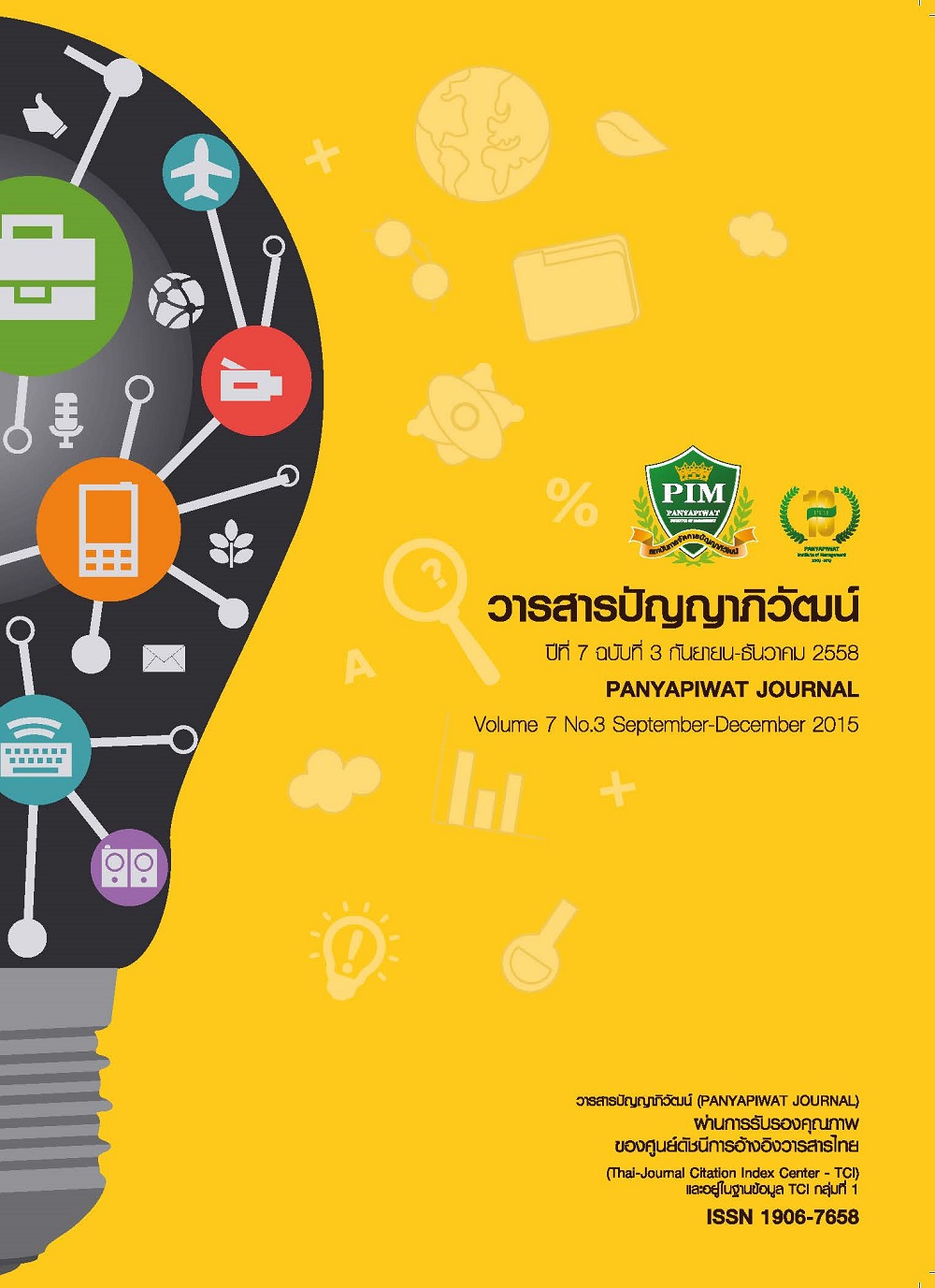ปัญหาการคุกคามทางเพศในอุตสาหกรรมบริการ: แนวคิด ผลกระทบ และแนวทางแก้ไข
Main Article Content
Abstract
การคุกคามทางเพศเป็นการกระทำหรือการแสดงออกทางเพศที่ไม่เหมาะสมต่อบุคคลอื่น อันอาจทำให้เกิดความรำคาญ ความอับอาย หรือการเสื่อมเสียเกียรติ ปัญหาการคุกคามทางเพศเป็นปัญหาสำคัญที่เกิดขึ้นในองค์การต่างๆ รวมทั้งองค์การด้านอุตสาหกรรมบริการ ซึ่งเกิดจากปัจจัยสำคัญหลายประการ อาทิ ปัจจัยด้านลักษณะงาน ปัจจัยด้านลักษณะของผู้ปฏิบัติงาน และปัจจัยด้านโครงสร้างองค์การ การเกิดขึ้นของปัญหาการคุกคามทางเพศนั้นส่งผลเสียทั้งต่อผู้ที่ถูกคุกคามทางเพศ ต่อองค์การ และต่อสังคมโดยรวมอีกด้วย ในการป้องกันและแก้ไขปัญหาดังกล่าวจะต้องร่วมมือกันทั้งตัวพนักงานในองค์การ ผู้บริหาร รวมทั้งหน่วยงานภาครัฐที่เกี่ยวข้องกับปัญหาดังกล่าว บทความนี้ผู้เขียนได้เรียบเรียงขึ้นจากข้อมูลที่ได้จากการทบทวนวรรณกรรมจากแหล่งต่างๆ ได้แก่ ตำรา รายงานวิจัย บทความวิชาการ รวมทั้งเว็บไซต์ โดยมีวัตถุประสงค์ที่จะนำเสนอแนวคิดเกี่ยวกับการคุกคามทางเพศ โดยเฉพาะที่เกิดขึ้นในอุตสาหกรรมบริการ เพื่อที่จะได้เข้าใจถึงสภาพปัญหา และสามารถนำไปประยุกต์ใช้ในการจัดการกับปัญหาดังกล่าวได้ต่อไป
Sexual harassment is a sexual act or expression considered abusive to others, which may cause annoyance, embarrassment or disgrace to victims. The sexual harassment issue is a major problem that occurs in various organizations, including organizations in the hospitality industry and is caused by several key factors, including the characteristics of jobs, the characteristics of workers and organizational structures. The emergence of sexual harassment will affect victims, organizations and society as well. One way to correct and prevent such problems is to work together with workers, managers and government agencies that are dealing with such problems. This article is written from a literature review, including books, research papers, academic papers and websites. This article aims to present the concept of sexual harassment especially as it occurs in the hospitality industry, in order to understand the problem and apply measures in dealing with such issues further.
Article Details
I and co-author(s) certify that articles of this proposal had not yet been published and is not in the process of publication in journals or other published sources. I and co-author accept the rules of the manuscript consideration. Both agree that the editors have the right to consider and make recommendations to the appropriate source. With this rights offering articles that have been published to Panyapiwat Institute of Management. If there is a claim of copyright infringement on the part of the text or graphics that appear in the article. I and co-author(s) agree on sole responsibility.
References
กระทรวงแรงงาน, พระราชบัญญัติคุ้มครองแรงงาน พ.ศ. 2541. สืบค้นเมื่อ 10 พฤษภาคม 2557, จาก http://www.mol.go.th/anonymouse/law_labour/protect_workers
กระทรวงแรงงาน พระราชบัญญัติคุ้มครองแรงงาน พ.ศ. 2551. สืบค้นเมื่อ 10 พฤษภาคม 2557, จาก http://www.mol.go.th/anonymouse/law_labour/protect_workers
ชลิดาภรณ์ ส่งสัมพันธ์. (2539), ข่มขืน: ความรุนแรงเชิงวัฒนธรรมในสังคมไทย. รัฐศาสตร์สาร, 19(3), 161-183.
ชัชวรรณ ปัญญาพยัตจาติ. (2556). ภัยคุกคามทางเพศ..ประเด็นที่ต้องทบทวน. สืบค้นเมื่อ 17 พฤษภาคม 2557,จาก http://m.thaihealth.or.th/healthcontent/special report/35313
ชุดาปณี ชิบายาม่า. (2547). ประสบการณ์การถูกคุกคามทางเพศจากการทํางาน: กรณีศึกษาลูกเรือของบริษัท การบินไทย จํากัด (มหาชน), วิทยานิพนธ์สาขาวิชาสตรีศึกษา, มหาวิทยาลัยธรรมศาสตร์.
บุญเสริม หุตะแพทย์. (2538), “ขอบข่ายของอุตสาหกรรมบริการ” เอกสารการสอนชุดวิชาอุตสาหกรรมบริการ นนทบุรี: สํานักพิมพ์มหาวิทยาลัยสุโขทัยธรรมาธิราช.
วณี บางประภา ธิติประเสริฐ. (2547). การคุกคามทางเพศในที่ทํางาน. กรุงเทพฯ: โรงพิมพ์เอดิสัน.
วณี บางประภา ธิติประเสริฐ และสุนันท์ พลอยจิ๋ว. (2548). คู่มือฝึกอบรมเพื่อการเสริมพลังและรณรงค์เรื่องการคุกคามทางเพศจาก
การทํางาน, กรุงเทพฯ: สํานักงานกองทุนสนับสนุนการเสริมสร้างสุขภาพ.
วิลาสินี พิพิธกุล. (2557). วาทกรรมเรื่องเพศในหนังสือพิมพ์. สืบค้นเมื่อ 11 ธันวาคม 2557, จาก http://www.tja.or.th/old/speak.doc
สํานักงานข้าราชการพลเรือน. กฎ ก.พ. ว่าด้วยการกระทําอันเป็นการล่วงละเมิดหรือคุกคามทางเพศ พ.ศ. 2553 สืบค้นเมื่อ 10 พฤษภาคม 2557, จาก http://www.ocsc.go.th/oCSC/th/index.phpoption=comdocman&task=doc_details&gid=493&Itemid=226
สํานักงานคณะกรรมการสิทธิมนุษยชนแห่งชาติ. (2556). ภัยคุกคามทางเพศในที่ทํางาน...ปัญหาที่รอการแก้ไข. สืบค้น
เมื่อ 17 พฤษภาคม 2557, จาก http://www.nhrc.or.th/2012/wb/th/print news detailphp?nid=1287
Aaron, T. & Dry, E. (1992). Sexual harassment in the hospitality industry. The Cornell Hotel and Restaurant Administration Quarterly, 33(2), 93-5.
Bargh, J. A. & Paula, R. (1995). The naive misuse of power: Nonconscious sources of Sexual Harassment. Journal of Social, 51(1), 87-90.
Bravo, E. & Cassedy, E. (1992). The 9 to 5 Guide to Combating Sexual harassment. New York: John Wiley & Sons Inc.
Chartered Institute of Personnel and Development. (2006). Harassment at Work Factsheet. CIPD.
Gillbert, D., Guerrier, Y. & Guy, J. (1998). Sexual harassment issues in the hospitality industry. International Journal of Contemporary Hospitality Management, 10(2), 48-53.
Hamilton, A. J. & Veglahn, P. A. (1992). Sexual harassment: the hostile work environment. The Cornell Hotel and Restaurant Administration Quarterly, 33(2), 88-92.
International Labour Organization. (2014). Sexual Harassment at work. Retrieved March 13, 2014, form http://www.ilo.org/wcmsp5/groups/public/---ed_norm/---declaration/documents/ publication/wcms_decl_fs_96_en.pdf
Mackinnon, A. C. (1979). Sexual harassment of working women. (2nd ed.). New Haven: Yale University Press.
Powell, G. N. (1993). Women and Men in Management. Newbury Park, CA: Sage Publications.
World Bank. (1994). Preventing and stopping sexual harassment in the workplace. Washington,D. C.
Yeung, S. (2004). Hospitality Ethics Curriculum: an Industry Perspective. International Journal of Contemporary Hospitality Management, 16(4), 25-262.
Translated Thai Refference
Hutapaet, B. (1995). “The scope of Hospitality Industry” Handout of Hospitality Industry Subject. Nonthaburi: The Office of the University Press Sukhothai Thammathirat Open University.[in Thai]
Ministry of Labour. Labour Protection Act. 1998. Retrieved May 10, 2014, from http://www.mol.go.th/anonymouse/law_labour/protect_workers [in Thai]
Ministry of Labour. Labour Protection Act. 2008. Retrieved May 10, 2014, from http://www.mol.go.th/anonymouse/law_labour/protect_workers [in Thai]
Office of the Civil Service Commission. Civil Service Act. 2010. Retrieved May 10, 2014, from http://www.csc.go.th/ocsc/th/index.php?option=com_docman&task=doc_details&gid=493&Itemid=226 [in Thai]
Office of the National Human Rights Commission of Thailand. (2013). Sexual threats in the workplace... Problems waiting to be solved. Retrieved May 17, 2014, from http://www.nhrc. or.th/2012/wb/th/print news detail.php?nid=1287 [in Thai]
Panyapayatati, C. (2013). The treat of sexual harassment...issue that need review. Retrieved 17 May,2014, from http://m.thaihealth.or.th/healthcontent/special report/35313 [in Thai]
Phiphitku, W. (2014). Discourse of Sexuality in the Newspapers. Retrieved December 11, 2014,from http://www.tja.or.th/old/speak.doc [in Thai]
Shibayama, C. (2004). Experiences of Sexual Harassment at Work: A Case Study of The Thai Airways International's Crews. Thesis of Woman Studies, The Graduate Volunteer Center,Thammasat University. [in Thai]
Songsamphan, C. (1997). Rape: Cultural Violence in Thailand. Political Science Review, 19(3),161-183. [in Thai]
Thitiprasert, W. B. (2004). Sexual Harassment in the Workplace. Bangkok: Adison Press. [in Thai]
Thitiprasert, W. B. & Ployjiw, S. (2005). Training Handbook for Strengthening and Campaign of Sexual Harassment at Work. Bangkok: Thai Health Promotion Foundation. [in Thai]


